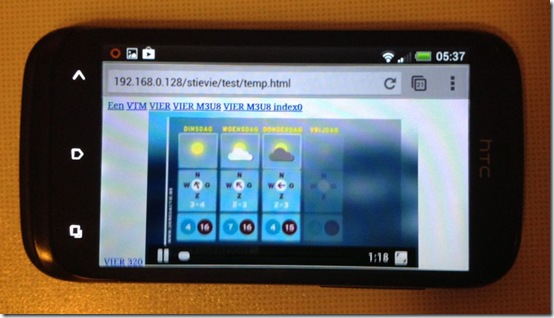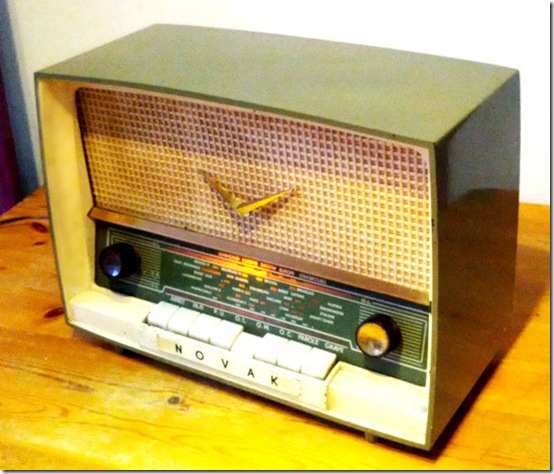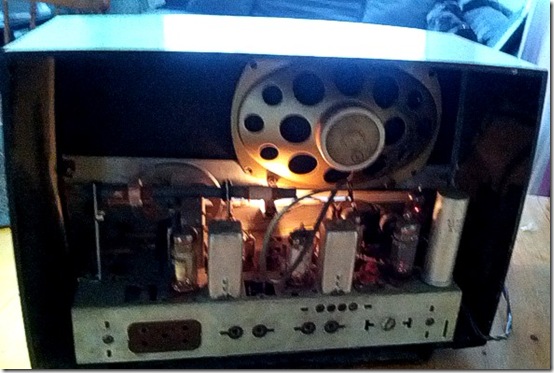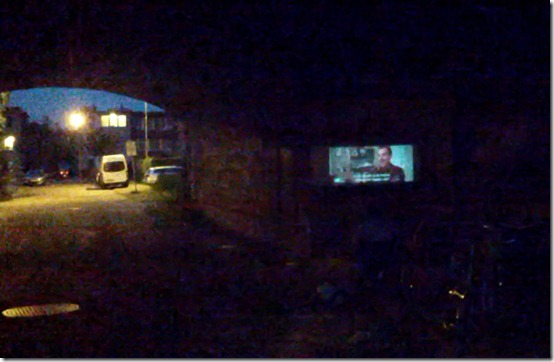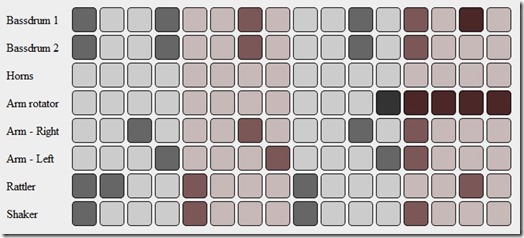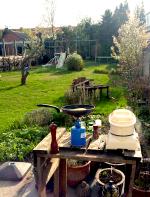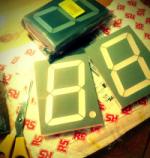Opening Up Stievie
Misschien heb je er iets van opgevangen: er is een nieuwe coole TV-kid in town: zijn naam is STIEVIE en het is een samenwerking tussen de VRT, VMMA en SBS.
Jawel! Wie had gedacht dat die 3 partijen netjes konden samenwerken?
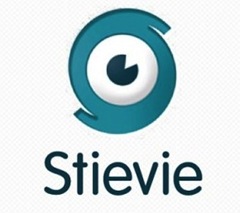
Het werd met veel fanfare aangekondigd en je kon je inschrijven om testkandidaat te worden.
70.000 mensen vulden een hele enquete in en gisteren werden de "uitverkorenen" op de hoogte gebracht.
10.000 mensen mochten binnen.
Dat wil zeggen dat 60.000 mensen wel hun hele TV profiel mochten opgeven, maar daarvoor niets in de plaats kregen.
60.000 mensen die dan als reactie hebben "Wat? Ik ben niet exclusief genoeg? Steek het dan maar diep in uw g*t"
Goe bezig :-)
Afin - voor alle duidelijkheid, ik was er ook niet bij hoor, bij die "gelukkige 10.000"
Maar niet getreurd! Waar een wil is, is een weg.
Tijd om eens te onderzoeken hoe die Stievie app in elkaar steekt.
Ze is gemaakt door het Nederlandse Triple-IT. Vroeger heette dat platform "Rumble", maar nu is het opnieuw gelanceerd als "Vinson"
Overigens: naar het schijnt bestaat er ver ver weg, aan de andere kant van de wereld, een vreemde woestenij met als naam "La Wallonie". Naar het schijnt hebben ze daar ook TV, iets van RTBF of zo?
Die slimme Hollanders van Triple-IT hadden hun applicatie al eens aan de RTBF verkocht, en die is al een tijdje beschikbaar als "TV Nomade" en meer: ge kunt dat zelfs helemaal gratis uitproberen.
Maar dit terzijde want wat over de taalgrens gebeurt bestaat niet voor de Vlaming en Triple-IT hebben hun app nu ook verkocht aan de Vlaamse media als "Stievie"
hups - open met die netwerksniffer (of eigenlijk de Charlesproxy: zeer gemakkelijk omdat die meteen ook HTTPS verkeer decrypteert)
Als je wil inloggen op de stievie app wordt er een verbinding gemaakt met http://rumble-vrtvmmasbs.triple-it.nl/
Uiteraard lukt dat niet want ik heb helemaal geen Stievie login, maar het geeft ons wel het eerste aanknopingspunt.
Nu wil het toeval dat Vinson ook een demo app heeft in de appstore.
Mijn boerenverstand zegt dat Stievie en Vinson helemaal identiek zijn en inderdaad.
Vinson maakt verbinding met http://rumble-vinson.triple-it.nl/
En even later zie je de video playlist opgehaald worden van https://playlistsvr-vinson.triple-it.nl
en voorwaar: een search/replace van vinson door de vrtvmmasbs van de login url geeft ons werkende stievie urls:
http://rumble-vrtvmmasbs.triple-it.nl/V1Api/Config/GetConfig/
en nog veel interessanter:
http://rumble-vrtvmmasbs.triple-it.nl/V1Api/Program/GetOverview
wat een nette programmagids in JSON oplevert. handig! 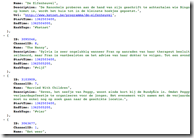
Wat verder gesnuffel aan de video urls zelf geeft ons moeilijke dinges als "session keys" en "urlvalidities" and "channel identifiers" en meer mumbojumbo maar dat blijkt allemaal maar een aanloopje te zijn naar het echte werk: de playlist:
https://playlistsvr-vrtvmmasbs.triple-it.nl/default.aspx?streamname=een&streamid=1
¤ttime=1362448835&urlvalidity=2400&streamduration=14400&userid=0
&key=FFF3335268D63D6F9E5E6DB9616AC235E25772BF&index=0
Dat ziet er nog lastig uit, maar Triple-IT heeft het ons gemakkelijk gemaakt en een beetje trial and error leert ons dat ge al die moeilijkdoenerij gewoon kunt overslaan:
https://playlistsvr-vrtvmmasbs.triple-it.nl/default.aspx?streamname=een&streamid=1 blijkt namelijk een werkende video stream van EEN te zijn.
Update: Het zijn rappe kerels hoor, daar bij Triple-IT: het gat is inmiddels gedicht. TOP!
(onderstaande urls gaan dus niet meer werken)
Handig gemaakt van Triple-It! Eerst een hele muur bouwen en dan vergeten de poort op slot te doen.
https://playlistsvr-vrtvmmasbs.triple-it.nl/default.aspx?streamname=vtm&streamid=9 is de stream van VTM
https://playlistsvr-vrtvmmasbs.triple-it.nl/default.aspx?streamname=vier&streamid=13 is de stream van VIER
Dus voor die 60.000 niet-geselecteerden:
Als ge via een iPad of iPhone surft, zoud ge normaal gezien gewoon op onderstaande logos moeten kunnen klikken.



op een recente Android (4.1 of hoger) en op safari op OSX zouden onderstaande links mogen werken.
De rest van de zenders moogt ge zelf uitzoeken.
Het zijn gewoon standaard HLS video streams (weliswaar met AES encryptie) die ge met eender welke player die dat ondersteund kunt afspelen.
op OSX en iOS is dat standaard, op windows kunt ge VLC gebruiken, op een recente Android wordt dat ook ondersteund.
Ziet dat hier eens properkes spelen. 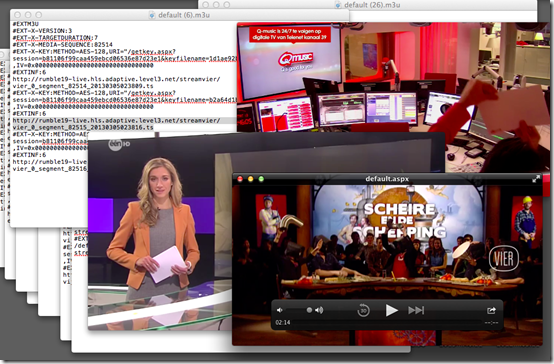
En ook op Android, gewoon zoals het hoort: in de browser
(en ja, ge kunt dat uiteraard ook op full screen zetten, maar dan is de screenshot niet veel zeggend hé) 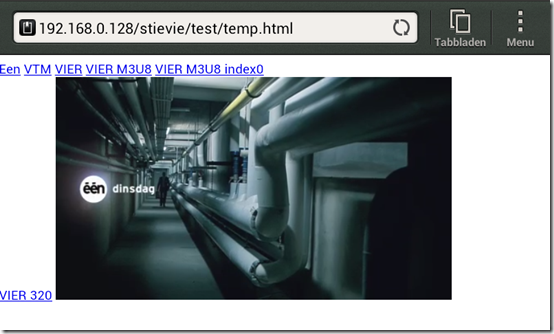
grappig eigenlijk:
default.aspx: hun platform draait op ASP.NET... Microsoft technologie dus. Toch vreemd voor een bedrijf dat zo hard op IOS en Apple gericht is.
Allez, tot zover Stievie ...
Ik vermoed niet dat het lang zal werken, hoor ... dus niet echt de moeite om er een Android appke rond te zetten.
De mannen van Tripple-IT zullen het gat wel rap dichtsmeren zeker? (Update: inderdaad: het gat is inmiddeld gedicht)
Allez hup: werk aan de winkel, of had ge heel uw security op https gebaseerd?
De S van https staat voor secure, inderdaad, maar https dient om uw eindgebruikers te beschermen tegen afluisteren, het doet niets-nada-noegabollen-noppes om uw applicatie te beschermen.
Aan de mensen van de VRT, VMMA en SBS : ge moet niet kwaad zijn op mij, hé - don't shoot the messenger - ge moet kwaad zijn op Triple-IT : zij hebben u een lekke applicatie verkocht.
Voor de volledigheid: hun VOD urls heb ik nog niet gevonden.
Ik vermoed dat die op https://rumble-vrtvmmasbs.triple-it.nl/V1Api/Category/GetOverview/ staan. Als iemand zijn Stievie login eens efkes wil uitlenen, dan wil ik gerust eens piepen. :-)
Efkes hé ... een mens heeft namelijk ook nog iets anders te doen dan de godganse avond voor de TV te hangen, nietwaar?
Enjoy!
Update 2: Die lieve stievie mensen gaven me een loginneke cadeau.
Ziedewel: mijn loyaliteit en goodwill zijn gewoon voor een appel en een ei te koop. :-)
Merci!
Oude Radio 3 (update: nu met Airplay)
Een nieuwe aanwinst in de familie.
Hij was TE schattig om te laten staan.
Het is een model 501 uit 1951 van het Belgische Novak.
Na een kleine opkuis- en vastvijsbeurt werkt hij weer prima.
Helaas zit er enkel een AM ontvanger in en geen FM.
Volgens de tijdslijn van de VRT vond de eerste FM radio-uitzending in 1947 plaats. Wikipedia plaatst het wat later maar in ieder geval was FM begin jaren 50 precies nog niet mainstream.
Gelukkig zit er ook een externe ingang in.
Waarschijnlijk wordt ie zo mee aan de Sonos gekoppeld.
Schoon gerief , daarvoor moogt ge me altijd uit mijn bed komen halen:-)
Update: Ik heb uiteindelijke een banale maar leuke toevoeging gedaan:
Er lag hier nog een oude Android telefoon waarvan het scherm kapot was.
Gelukkig was de wifi al wel geconfigureerd.
Ik installeerde er het geweldige "Airbubble" op, wat van elk Android toestel een Airplay ontvanger maakt. De stroomtoevoer tap ik af van de voeding van de radio, en ik connecteer gewoon de audio-out van telefoon rechtstreeks met de audio-in van de radio. Een restje ducttape houdt de telefoon op zijn plaats.
Et Voila: De radio wordt nu gebruikt als Airplay enabled speaker.
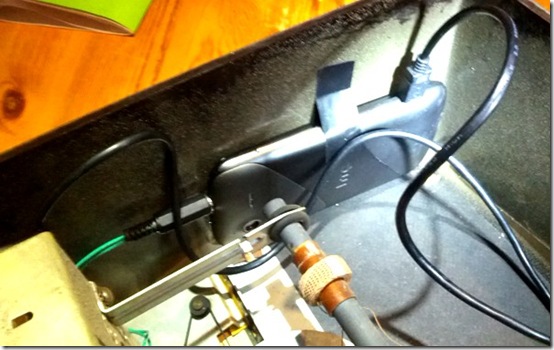
niet slecht, voor 30 euro.
Een GSM is natuurlijk niet de meest stabiele "always on" audio-receiver.
Ik zou het kunnen vervangen door een Rasberry Pi met RaspBMC , ofwel duw ik er gewoon een Airport Express in.
Airplay via een echte buizenversterker - als dat geen mooie combinatie is!
Over tekenen en sex met opblaaspoppen
Het is altijd een tweestrijd: een pragmatische geek zijn.
De geek is altijd verzot op gadgets en features en nieuwe mogelijkheden, het liefst digitaal en is best rationalistisch.
De pragmatische mensch is een beetje de antirationalist: altijd op zoek naar het buikgevoel, naar het "echte", naar de Platoonse essentie en heeft een hekel aan overbodige franje en ceremonie.
Bij grafische bezigheden komt dat altijd nogal hard naar voren: de digitale mogelijkheden zijn oneindig en de geek in mij is er helemaal verzot op.
Anderzijds kan niets het werken met echte materialen evenaren: het gevoel van een penseelstreek op een doek, of een potloodlijn op grof papier.
Sensueel ... ik verzeker u.
Op tablets zoals de iPad is het leuk tekenen, maar ...
Met een pen of je vinger over een glasplaat vegen ... ook dat kan ik verzekeren, daar is in de verste verte niets sensueels aan.
Vergelijk het een beetje met seks met een opblaaspop: het voldoet misschien, maar het komt niet in de buurt van "the real thing".
(vermoed ik toch ? the real thing schijnt nogal tof te zijn)
Plastic is geen vervanging voor buikgevoel.
Alle beetjes helpen echter en zo ontdekte ik plots de JAJA tekenpen van Hex3. 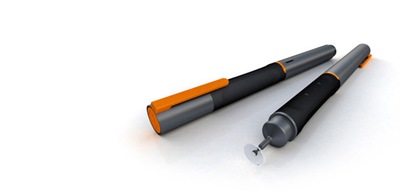
De prijs is vrij hoog maar ligt nog wel onder de impulsaankoopgrens. KOOP! (kijk, zo pragmatish ben ik dan ook weer ...)
Het is op zich gewoon een tekenpen voor touchscreens, maar door een vrij vernuftig systeem van bijna-ultrasoon-geluidjes die de pen uitstuurt en de tablet continu opneemt "weet" de software hoe hard je drukt op het scherm en kan daar dan iets mee doen.
Dat is een wezenlijk verschil: potlood- pen- en verfvegen reageren zo echt op de druk die je zet, wat de ervaring veel realistischer maakt.
Hieronder een kleine schets met de pen, gemaakt tijden een rit van 90 minuten tussen Hasselt en Ekeren
Jaja, dankzij de NMBS heb ik allemaal tijd voor dergelijk genot: dank u NMBS!
De titel is "And the developer performed a cool Triple Push Commit"
_thumb.png)
't is gemaakt in ProCreate: een echte aanrader voor tekenaars en veel beter dan mijn vorige favoriet Sketchbook Pro
De pen werkt trouwens ook prima op Android, maar echt goede tekenpakketten heb ik daar nog niet gevonden.
Ik moet zeggen: het zorgt zonder meer voor dat lekkere smeuige handgemaakt effect, wat best moeilijk te bereiken is met digitale technologie.
Overigens is dat evenzeer de verdienste van ProCreate dan van de JaJa pen, maar het is een prima combinatie.
Hier een detail: 
ProCreate heeft echt een goede teken-engine: de blending tussen lagen en kleuren is prima en het is 1 van de weinige tekenapps die een goede "smudge" functie heeft.
Maar toch ... het blijft een stukje plastic dat over een glazen plaat schuift.
Daar zit toch nog een hoop ruimte voor verbetering, hoor, in die tablet technologie: een oppervlak dat op zich drukgevoelig is en mooi reageert met haptische feedback en aangepaste oppervlakte weerstand. Alles afzonderlijk bestaat dat al in prototype, maar het zal nog even wachten zijn voor dat in 1 device tot de consument is geraakt.
Ondertussen zal ik me wat behelpen met de Jaja en proCreate.
Het mag dan wel nep-sex zijn, het is toch wel fijn.
Guerilla Cinema
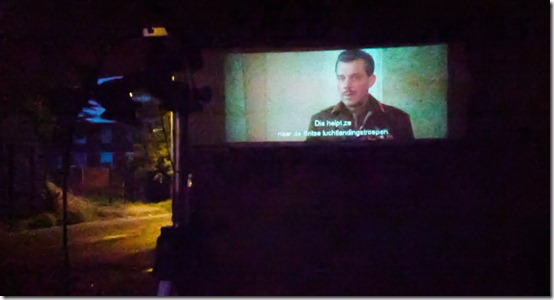
Dat is nu eens een leuk concept: Guerilla Cinema:
Ge spreekt met wat mensen af op een mooie zomeravond ergens op een publieke plaats die toch rustig en donker is.
Iemand brengt een klein projectorke, een film en wat geluidsversterking mee (met een hoop reserve batterijen) en de rest een stoeleke en wat te drinken.
Instant cinema !
Nieuwsgierige voorbijgangers kunnen gewoon mee aanschuiven.
Als eerste try-out kozen we de brug onder de (vracht)spoorweg op "De noteschelp" in Ekeren.
Perfecte locatie... zeker met een bijpassende film: "A Bridge Too Far" uit 1977: een oorlogsfilm over de stevig foutgelopen "Operation Market-Garden" van WOII
Echt een meerwaarde, zo'n plekske onder een brug met geregeld het gerommel van de treinen boven uw hoofd.
Moeten we nog eens doen, dus als iemand nog een mooi plekje met bijhorende film in gedachten heeft... ge weet mij te vinden.
Update:
En dat deden we, zaols je hier op frevanoers.be kunt lezen.
Update 2:
Nummer 3 gaat waarschijnlijk "12 Angry Men" worden.
Update 3:
En de volgende: No man's land
My Little DrummerBot
Yay! finally took the time to finish a little Arduino project.
It's a another bot, more specific: a web controlled drummerbot!
Yes yes, the same old trick: web interfaces to physical objects: Me LUVS them.
Give me an Arduino and a browser and I'll build you your rainbow
Hey, I feel a song comming up!
Tap the drum pattern on your phone and this little bot will rock it!
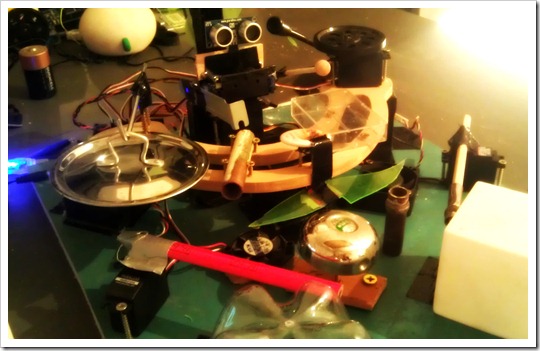
You control it like most drum computers: you draw the beats on a pattern of sixteen dots, perfectly suited for generic 4/4 rhythms.
There a 8 lines, each controlling 1 servo motor.
Most of the servo's have a percussion item both on the left and the right, that's why the pattern buttons have 3 states: off, left, right.
That makes 14 distinct percussion sounds for the drummerbot.
The pattern in the webbrowser is packed into a string, which get send to the Arduino via HTTP.
You can use a wifi module and a http server on the Arduino, or you can use another device attached to the Arduino through a comm port.
The Arduino receives the string, unpacks it back to a pattern and simple loops over the steps controlling each servo.
the "DrummerBot Step Seqeuncer V 0.01 very-much-alpha" page is here
You can also download the Arduino code here.
I must admit: the drums sound a bit dry without amplification though.
I recorded everything into Ableton Live and did the final mix there. (Shocking, right? The videoclip is actually NOT a live performance :-) )
I'm specifically fond of the "Horns"
They are 2 little fans with a servo pushing a piece of plastic against the blades.
A hell of a noise but when you add heaps of fuzz, chorus and overdrive effects they are pretty convincing.
I call them F*CK-YEAH-HORNS
If you want to jam along yourself: hop over this saturday to Barcamp Antwerpen, where I'll be giving a presentation with/about the bot.
Let's play!
Warning! contains facts, analyst says
Analyst says that 50% of you will read this blogpost.
How about you, are you reading this post?
This is part 2 of the "How to be a full time tech blogger" series.
I've done some extensive analysis myself by reading less then half a dozen blogposts - in specific, 4 blogposts about the analysis of the effect of the new iPad.
Boy Genius reports: "Canaccord Securities analyst Mike Walkley says ..." that "Android tablets can’t compete with the iPad"
Meanwhile, just one day before, the same blog claims that "Analytics firm Strategy Analytics reports ..." that "Android tablets finally dent iPad market share"
At the same time, "global market intelligence and consulting firm IDC" predicts that Android tablets will overtake the iPad in 2016.
Hey, but what do they know, they're just market intelligence and consulting dudes, not analysts like "Needham analyst Charlie Wolf" who sees that "Apple’s iPad will still dominate tablet market after a decade"
Confusing? not at all, that's the beauty of it: since everything is an opinion, everybody is right!
Currently I'm writing a whitepaper on a method of analysis of technology related articles aiming to chart the relationship between relevant info and specific vocabulary,syntax and grammar.
I don't have any hot graphics for you just yet, but I do have some useful insights I'm willing to share:
- the amount of the word "analysis" seems directly proportional to the amount of "IMPORTANT RELEVANT INFO" in the article
- the location of the word "analysis" is a duality: small to normal amounts of "IMPORTANT RELEVANT INFO" seem to prefer the word "analysis" at the start of the sentence but for the greatest impact, the really big "IMPORTANT RELEVANT INFO" put the word at the end, right after the comma. e.g. "in 4 decades time, plain paper will be completely replaced by electronics, analyst says"
- Every "call to action" doubles the "IMPORTANT RELEVANT"-value of the preformentioned IMPORTANT RELEVANT INFO.
Let me clarify that last point.
Every writer knows that every blogpost should end with a big fat "Call to Action" - right?
No post is worth reading - let alone worth writing - without one.
Don't take my word for it - everybody says so
To really spice up your point, you must engage your readers, pull them in, get them clicking - and the ultimate weapon of choice is "ask them for their opinion so they can be an authorative analyst too" , right?
It's all a matter of efficiency.
What's the most time consuming part of writing non-fiction articles?
It's checking the facts.
Now here it is: the golden tip:
Everytime you write about what someone else says or predicts or sees some interesting correlations happen
- You don't have to hunt for news yourself as someone else already has written it down for you
- There are no facts. Ergo: you never can go wrong.
- Lifting the simple fact of fact-checking out of the equation, cuts your valuable writing time in half.
That's not a Win-Win , that's a Win-Win-Winning!
Cover it up by asking your reader for their analysis and BOOM! the easy-peasy never-wrong instant formula for filling up your tech blog.
Everyone can do it - so can you.
So, What do you think?
Aren't you glad you've read this highly valuable important relevant piece of info?
NMBS SMS en nog wat acroniemen
Allez, nog rap een postje over de NMBS en dan zwijgen we erover.
Jaja, ik weet het: NMBS en SMS zijn geen echte acroniemen, maar wat zou het.
Het werd al een kleine 4 jaar geleden aangekondigd, maar sinds kort zag ik het ook effectief verschijnen op http://m.nmbs.be: "Koop je ticket" bij NMBS mobility.
Niet via een schone PDF met barcode, maar via SMS. Jawel, laagdrempelig en al!

"Pay by phone" daar ben ik wel voor te vinden, vooral omdat het mij meer dan eens overkomt dat ik per ongeluk zonder centen of portefeuille op stap ben.
Maar op stap zonder smartphone? Never.
Direct uitproberen dus!
De afgelopen 2 weken nam ik 12 keer de trein, telkens met 1 overstap en kocht telkens een SMS-ticketje.
Meestal ging dat vlot, maar niet altijd.
Ik kwam 10 keer een (verschillende) conducteur tegen. Op 24 treinen is dat 42%
Van deze 10 conducteurs kreeg ik 10 keer de reactie "Ha, dat is de eerste keer"
Het goede nieuws is dat ze op zijn minst allemaal op de hoogte waren van het bestaan van het SMS ticket, het minder goede nieuws is dat het blijkbaar nog niet veel gebruikt wordt.
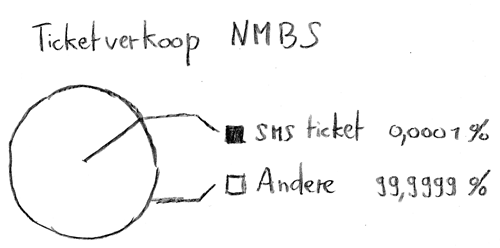
Van deze 10 conducteurs kreeg ik 10 keer de reactie "Oei, meneer, dat is wel veel werk om te controleren"
4 conducteurs gingen effectief over tot controle van het ticket.
2 conducteurs slaagden er effectief in het ticket te controleren.
Bij de 2 andere was er steeds een technische defect (van de kaartlezer of de dataverbinding)
2 conducteurs vroegen daarbij effectief mijn identiteitskaart.
Aantal keren effectief gevalideerde SMS tickets t.o.v. het aantal treinen: 8,3% 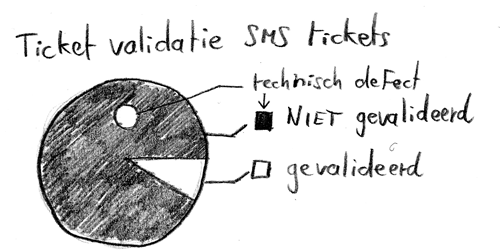
Van deze 10 conducteurs kreeg ik uiteindelijk 10 keer de reactie "Allez, 't is goe"
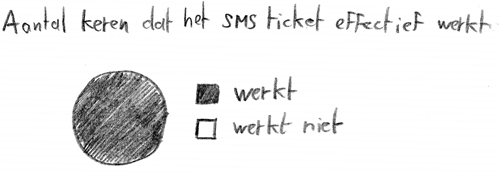
Een succes-rate van 100% ... dat is toch niet slecht!
Proficiat NMBS.
Ik stelde ook bij alle 10 conducteurs de vraag "Is dat nu gemakkelijk voor u, dat ik zo'n SMS ticket koop"
Dit waren de types antwoorden.
3x "Voor u wel hé, meneer"
3x "Het is wel veel werk voor ons om te controleren"
2x "Och, 't is weer iets nieuws hé"
1x "Ik zou er toch geen gewoonte van maken, hoor"
1x "Ge zou toch beter een gewoon kaartje kopen"
Ik was eigenlijk beretrots op mijn SMS-ticket.
Wat is er nu heerlijker voor een Geek om zijn smartphone te kunnen flashen in een duidelijk geval van "real-world practical problem solving" ?
De treinbegeleiders deelden mijn enthousiasme precies niet.
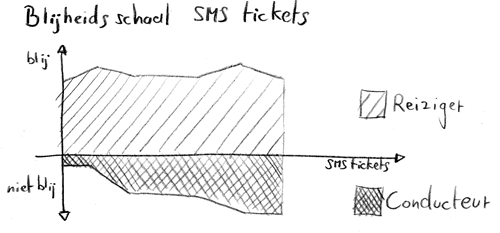
Overigens is het niet altijd een goed idee om zo'n SMS ticket te kopen als je al op de trein zit: het kan tot 5 minuten duren voordat je effectief de SMS binnenkrijgt, wat toch wel een hoeveelheid stress met zich meebrengt.
Wat als de treinbegeleider langskomst en de SMS is nog niet aangekomen?
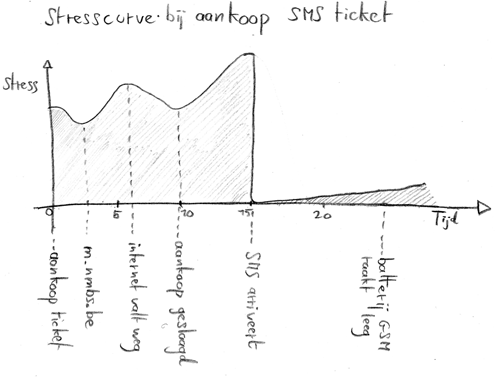
Maar ik stel me eigenlijk de volgende vraag:
Zonder actief "vals te spelen", is het eigenlijk wel een goed idee om een kaartje te kopen voor je op de trein stapt?
Een ticketje kopen op de trein bij de conducteur, dat kan.
Normaal gezien moet je daar 3 euro "aanmaakkosten" voor betalen als je de conducteur vooraf verwittigt, anders 12,50 euro.
Nu woon ik toevallig dicht bij een station waar geen automaat of loket is, dus dan valt die kost weg.
Ik doe erg uiteenlopende trajecten waardoor een abonnement niet voordelig is voor mij, maar laat ons de gemiddelde kost van een rit op 10 euro zetten.
Op een maand tijd doe ik gemiddeld 20 trajecten - zoals gezegd: niet steeds dezelfde.
Stel ik koop altijd een ticket , dat kost mij 200 euro per maand.
Stel ik koop steeds pas een ticket als de conducteur langskomt - de helft van de tijd ben ik dan vertrokken vanuit een station zonder automaat of loket.
Kans op toeslag? 50%
Kans dat ze u effectief 12,50 euro aanrekenen als ge vriendelijk blijft? 17% (empirisch vastgesteld)
De overige 83% betaalt ge 3 euro toeslag.
Gemiddelde toeslag? (12,50*17/100 + (3*83)/100)/2 = (2,125 + 2,49)/2 = 2,30 euro
Dus als ge een conducteur tegenkomt betaalt ge gemiddeld 12,3 euro.
Kans op conducteur? 42% (zie boven)
Dat maakt ((20 trajecten*42)/100) * 12,3 euro = 103,32 euro per maand
Voila: dat is toch een duidelijk bewijs dat ge beter geen ticketje koopt, niet?
Dan spaar ik per maand 96 euro uit.
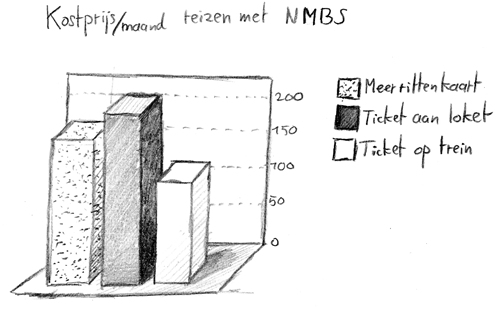
Stel dat ik nog geen smartphone heb en ik wil toch een SMS ticketje kopen?
Een deftige smartphone kost pakweg 400 euro.
Mobiel internet via Mobile Vikings kost 15 euro per maand.
6 maanden NMBS rijden zonder vooraf ticketjes te kopen bespaart mij 6*96 euro = 576 euro.
6 maanden smartphone + internet kost mij (400 + 6*15) = 490 euro.
Dan heb ik nog 86 euro over.
1 twix in de automaat van een NMBS station kost 80 eurocent, dan kan ik 107 twixen kopen, wat ongeveer 1 twix per traject is. PERFECT! It all adds up!
Conclusie:
Door geen ticketje te kopen bij het opstappen bespaar ik genoeg zodat reizen met de NMBS mij elk half jaar een nieuwe smartphone + internet oplevert.
Daarnaast is er nog de tijdsbesparing door niet te moeten aanschuiven aan het loket.
Een ticket kopen aan het loket kost gemiddeld 2 minuten.
Stel dat 5% van de reizigers geen abonnement heeft.
de NMBS vervoert jaarlijks pakweg 220 miljoen mensen.
Dat zijn 11 miljoen verkochte tickets aan het loket = 22 miljoen verloren minuten = 45.000 werkdagen per jaar dat de reiziger wint.
Voor de treinbegeleider duurt het controleren van een SMS ticket ongeveer 30 seconden, wat maakt dat de NMBS 11.000 werdagen per jaar extra moet investeren om al die tickets te controleren, wat neerkomt op 37 extra full times (OK, er is dan wat minder werk aan de loketten, dus pakweg de helft kan daar dan gerecupereerd worden)
Hoe meer mensen geen ticket kopen aan het loket, hoe meer tijd en geld de reiziger bespaart en hoe meer tijd en geld het de NMBS kost. 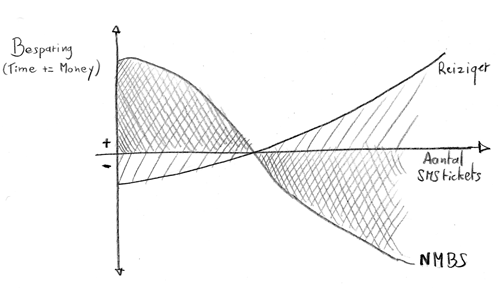
NMBS ... I love you!
Oude radio
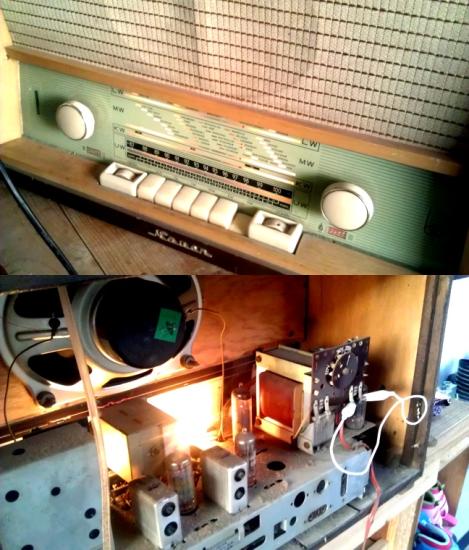
Cool!
Na minimale reparatie doetie het nog! #ouderadio #1960 #duitsedegelijkheid
het is den deze : een Bernau / Nauen 1133.1-0 die destijds blijkbaar 490 DM koste en we nu 20 euro hebben betaald.
Eigenlijk was het de bedoeling om er een Sonos Play:3 in te verstoppen, maar goed, nu zullen we hem als gewone radio gebruiken, na een half minuutje opwarmen klinkt ie eigenlijk nog verbazen goed.
meer dan dan 50 jaar oud al!
Geweldig eigenlijk, dat die radiotechniek op een halve eeuw geen snars is veranderd.
Of een klein beetje toch: de tuning van de radio gaat maar tot 100 MHz dus de hoofd frequency van Studio Brussel valt net buiten de boot.
Ook schattig dat de Duitse lange golf radiozenders van die tijd netjes op de glazen frontplaat staan - hoe nostalgisch.
Tags: in 't Nederlands, LifelogGeef je reactie (0)
NMBS-Compensat-o-matic
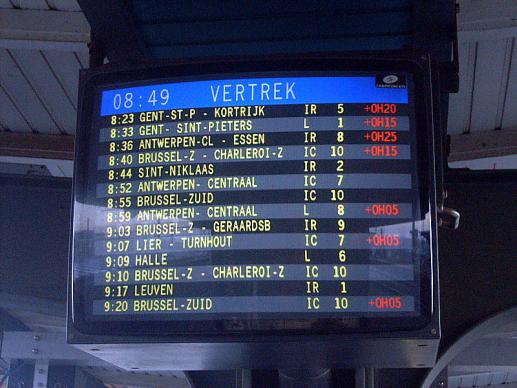
Zagen op de NMBS, dat doen we graag en dat doen we veel.
Reizen met de trein is zalig, behalve als je ergens op tijd moet zijn.
Ik reis bijvoorbeeld vaak van Mechelen naar Ekeren.
Een rechtstreekse verbinding: instappen, TV serieke opzetten en een half uurtje later terug uitstappen.
Zalig.
Behalve als het mis gaat.
![]() "Wegens een personen ongeval in Luttre heeft de trein naar Antwerpen Centraal - Essen 35 minuten vertraging."
"Wegens een personen ongeval in Luttre heeft de trein naar Antwerpen Centraal - Essen 35 minuten vertraging."
Kan gebeuren - en niet erg want mijn collectie TV series groeit sneller dan dat ik ze kan kijken.
Zo'n beetje ongeplande vrije tijd is best welkom.
![]() "Wegens een defect aan de seininstallatie kan de trein het station niet inrijden"
"Wegens een defect aan de seininstallatie kan de trein het station niet inrijden"
Murphy: een ongeluk komt nooit alleen.
Toch neem ik niet de eerstvolgende trein naar Antwerpen want dan moet ik weer overstappen en zo.
Nee, voor mij geen stress, beter wat wachten en rechtreeks rijden.
En zie daar: de trein rijdt binnen en vertrekt, slechts 45 minuten vertraging.
![]() "Wegens te grote vertraging zal deze trein niet verder rijden naar Essen, maar in Antwerpen Centraal direct terugrijden naar Charleroi"
"Wegens te grote vertraging zal deze trein niet verder rijden naar Essen, maar in Antwerpen Centraal direct terugrijden naar Charleroi"
Bummer - nu moet ik toch overstappen, en dan nog wel op een boemeltreintje want de volgende InterCity … heeft ook 45 minuten vertraging.
Jawadde, het is precies de eerste trein sinds lang richting Essen, want er zit wel 50.000 man op.
Niet erg - een beetje socializen met je mede lotgenoten is niet verkeerd.
Alleen jammer dat de trein maar niet vertrekt.
![]() "Wegens een elektrische storing tussen Berchem en Antwerpen zit de bestuurder van deze trein nog vast op een vorige trein"
"Wegens een elektrische storing tussen Berchem en Antwerpen zit de bestuurder van deze trein nog vast op een vorige trein"
Allez dan…
Na een halfuurtje socializen is iedereen precies wat uitgepraat en wordt er vooral veel gezucht.
en veel getelefoneerd.
Zo van "Papa, kunt gij mij komen halen" en zo.
26 graden in oktober is fijn, behalve (alweer) als je met 50.000 mensen in een stilstaande trein staat.
De conductrice is zichtbaar opgelucht als ze aankondigt dat de treinbestuurder gearriveerd is en inderdaad: we vertrekken.
Na 2u15 minuten stap ik af in Ekeren - 1u40 minuten vertraging - toch best wel veel - vooral omdat ik het laatste uur als sardien niet eens in de mogelijkheid was een boekske te lezen of een filmpje te zien.
Nu - niet getreurd: de NMBS heeft daar een oplossing voor.
Bij vertragingen van meer dan 60 minuten kun je namelijk een compensatie aanvragen.
Je moet enkel een formuliertje invullen, dat terugbezorgen aan de NMBS en je krijgt de waarde van je ticket terug.
pas op, niet in centen hé, je krijgt een waardebon die je kunt gebruiken om je volgende ticket te kopen.
Een geweldige oplossing, vooral omdat je voor dat formulier allerlei info moet gaan opzoeken, zoals de treinnummers van de treinen die je normaal had genomen, en de treinnummers van de treinen die je uiteindelijk hebt moeten nemen.
Parate kennis, als het ware.
Want wie wil er nu niet - na een dik uur tijd verlies- nog eens een half uur spenderen aan het invullen van een compensatieformulier, right?
"Dat moet toch beter kunnen" - denk je dan als developer.
Per slot van rekening staat al die info die je nodig hebt ergens online, en heeft haast iedereen tegenwoordig zo'n super smartphone die
- online gegevens kan opvragen
- weet hoe laat het is
- weet waar je bent
- foto's kan nemen
PING!
*idee*
De NMBS-Compensat-o-matic app voor op je telefoon
Stel je het volgende scenario voor:
Als je met de trein reist en je merkt dat je vertraging zal hebben, start je de app en je duidt aan naar welk eindstation je moet gaan.
De applicatie begint op dat moment je locatie te loggen en contacteert de geweldige iRail API om na te vragen welke treinen (en treinnummers) je zou moeten nemen en wat je normale aankomsttijd zou zijn.
Constateert de applicatie dat je na een paar minuten nog altijd op je startpunt bent, dan wordt er vanuit gegaan dat je vertraging hebt.
Als je geo-locatie plots wijzigt weet de applicatie dat je op een trein zit en gaat aan de verschillende databanken, zoals railtime.be en iRail vragen welke trein dat zou zijn.
Stel, je positie blijft een paar minuten hangen op een bepaald trein station, dan weet de applicatie dat je waarschijnlijk een overstap aan het maken bent en gaat weer op zoek naar de treininfo.
Als je geo-locatie overeenkomt met je eindstation weet de app dat je bent aangekomen.
Je aankomsttijd wordt gelogd en als de vertraging meer dan 60 minuten bedraagt krijg je een signaal met de vraag of je even een foto wil nemen van je treinticket.
Je krijgt je route met treinnummers en vertragingstijden op je scherm en na je bevestiging wordt alles netjes gepost naar het juist elektronische formulier van de NMBS.
Bedraagt de vertraging minder dan 60 minuten maar meer dan 15 minuten, dan slaat de applicatie dit op voor later: als je namelijk meer dan 20 keer op 6 maanden tijd 15 minuten vertraging hebt wordt dit ook gecompenseerd.
Simpel, automatisch en pijnloos: de klant krijgt waar hij recht op heeft en de NMBS heeft weer extra motivatie om hun treinen op tijd te laten rijden. iedereen content!
Hoera!
Jammer dat ik voorlopig geen tijd heb om de app te maken, maar als er iemand anders goesting in heeft: go ahead!
Het is een applicatie die zijn investering volgens mij snel terugverdient.
Je zou zelfs pro-actief kunnen gaan werken: stel je komt netjes op tijd aan maar op een ander moment van de dag is er wel een vertraging van 60 minuten op je traject .
Voor hetzelfde geld had je daar ook ingezeten, niet?
Dan is het toch niet meer dan redelijk dat de applicatie je daar van op de hoogte brengt zodat je alsnog met je ticketje de compensatie op kunt strijken, nietwaar?
Al was het maar ter compensatie van al die keren dat je net NIET aan die 60 minuten kwam.
Goed idee, nu alleen nog uitvoeren.
De NMBS-Compensat-o-matic - hopelijk ooit op een smartphone in je buurt.
P.S - je kunt natuurlijk al raden wanneer deze lange blogpost is geschreven …. inderdaad!
De vertraging bleef vandaag gelukkig beperkt tot 25 minuten.
De foto hierboven is overgenomen van Nmbs.TV
Spitting Image
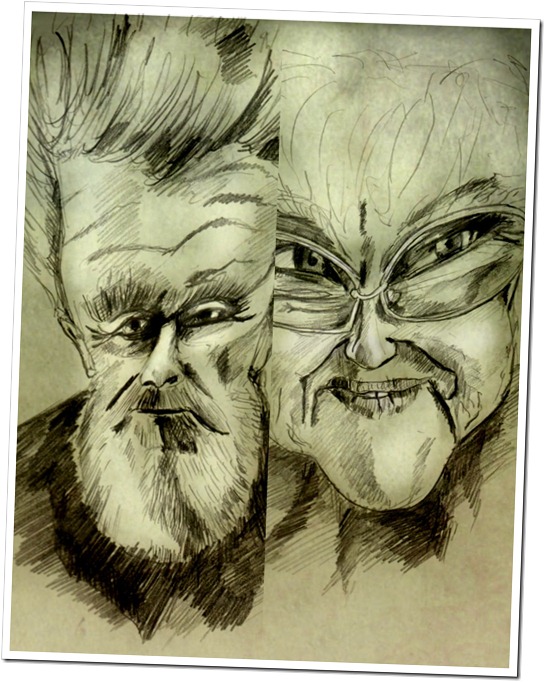
een portretje van mijn Ma en mijn Pa
Spitting Image!
Vakantie Voeten
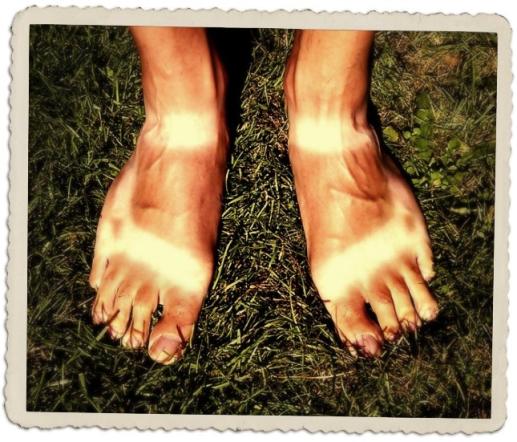 Vakantie is
Vakantie is - een paar weken op sandalen rondsleffen zodat ze onwisbaar in je voeten gebruind staan
- een paar weken offline zijn en het geen seconde missen
- geen plannen maken, behalve dan: "rijden naar daar waar de zon schijnt"
- zo ontspannen zijn dat je je niet kunt herinneren of je het laatste uur nog een gedachte hebt gehad
- achteloos met je VISA kaart staan zwaaien om pas later - veel later - aan de consequenties te denken
- na een paar weken verbaasd terug naar het TV journaal kijken
- het thuisgevoel krijgen als je dicht bij de grens Studio Brussel plots terug kunt ontvangen
- terug thuis komen en vreemd naar je eigen huis kijken waar je plots al die onaffe hoeken herontdekt
- terug voor 1 enkele seconde je computermuis coördinatie moeten zoeken
- terug goesting hebben
whatever versus whatever
Marco Arment "translates" (or trashes) The Ars Technica Galaxy Tab 10.1 review.
Translation: Android tablets have managed to copy the iPad's hardware well enough - the easy part - but have failed to provide good software and significant third-party app choice - the hard part.
So, with similar hardware with similar capabilities selling at similar prices, why should someone choose an Android tablet over an iPad?
Only die-hard Android fans should buy this, and even most of them won't enjoy it.
Dude, why so narrow minded?
You love your iPad. Good for you.
Why is it so hard to see that other people have other needs, tastes and preferences?
The ongoing Android versus IOS debate is a moot point.
You know that shouting game? 2 groups of kids shouting which is the better color, Red or Blue?
Same thing.
(and FYI, scientific study shows that red seems to have the upper hand )
It's like arguing which soccer team is better, FS Barcelona or Manchester United.
Which is the better car? BMW or Mercedes ?
In fact: even more scientific studies point out that the love for all things Apple is like a religion
No point in arguing.
People are grasping at whatever they can just to defend "their side": objectivity is for the weak!
I too have my preference and without emotional arguments I can simply observe my own behaviour:
I'm not a die-hard Android fan but I'm a die-hard tablet fan.
I have both an iPad and Android tablets in various sizes.
The iPad is a very nice toy and yet: when I crash in the couch, when I'm on the train, when I'm answering nature's call in the bathroom, when I'm in a meeting ... it's an Android tablet that's with me.
As smooth and fun as the iPad may be, the Android tablets are just more functional and easier for the things I want to do.
I'm not saying an Android tablet is better, I'm saying it's better suited for me.
If mister Arment can't see why some people prefer an Android tablet over the iPad then he certainly isn't troubled with an overly broad perspective.
Oh well, each to his own.
but if we all can agree that this debate is pointless, let's avoid polluting the interwebs (and my feedreader) with such garbage and focus on building kick ass applications, shall we.
On whatever platform, using whatever technology.

